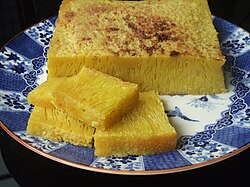This article needs additional citations for verification .(August 2021) |
 | |
| Type | Cake, kue |
|---|---|
| Course | Dessert or snack |
| Place of origin | Indonesia |
| Region or state | Medan, North Sumatera |
| Main ingredients | Tapioca and sago flour, eggs, sugar, coconut milk |
| Variations | Kue bingka |
| Similar dishes | Bibingka, Malay sponge cake, Bánh bò |
Bika ambon or golden cake or golden kuih bingka in Singapore, is an Indonesian dessert made from ingredients such as tapioca flour, eggs, sugar, yeast and coconut milk. Bika ambon is generally sold in kaffir lime or pandan flavor, but today it is also available in other flavors like banana, durian, cheese and chocolate.
Contents
Originating from the city of Medan in North Sumatra, the cake is usually cooked twelve hours[ citation needed ], so that it can last in the best condition and according to what is desired for four days because after that the cake starts to harden.
This cake is a further development of kue bingka, a famous traditional cake in the eastern parts of Indonesia.
The cake is notable for its sponge-like holes, which are formed by yeast in the cake dough that creates bubbles. These holes give it a unique spongy texture when it is baked. It is a close analogue of the Malay sponge cake, due to similar spongy holes, but the moisture and texture are slightly different.

